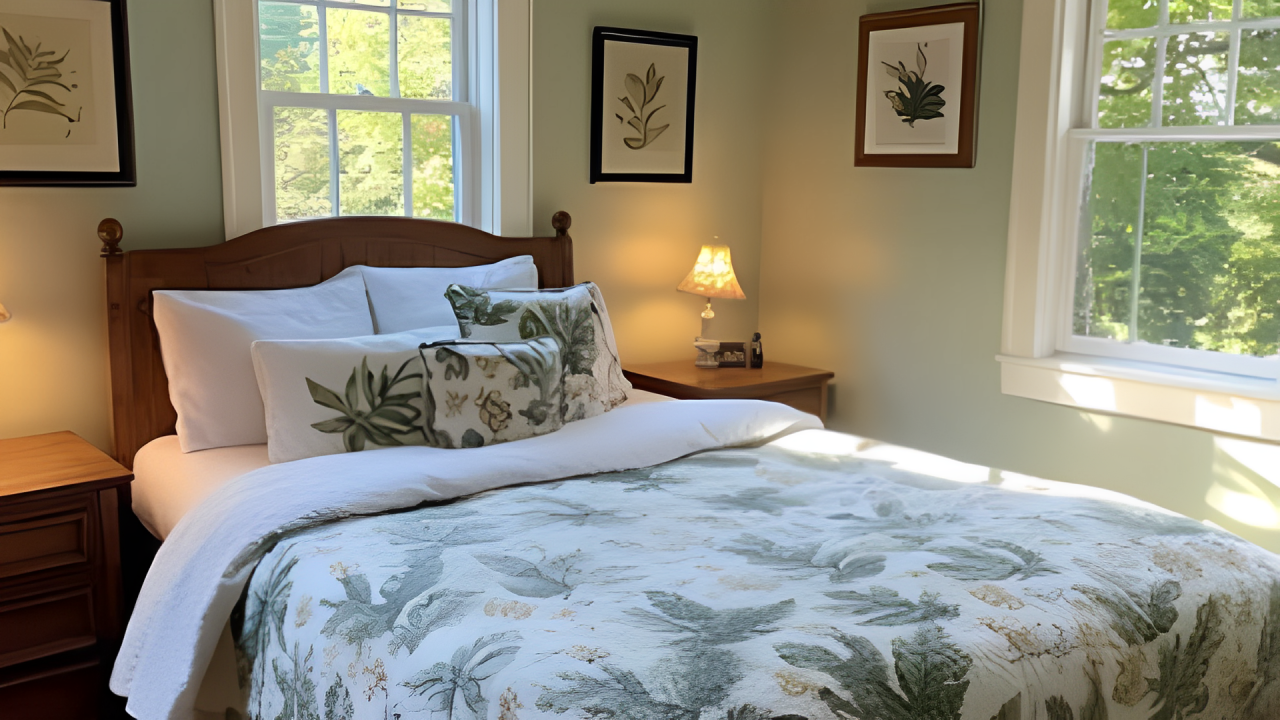A Guide to Perfect Bedroom Colors starts with understanding color psychology. The right shades can create a calm, restful environment that enhances sleep quality. Soft blues, gentle greens, and warm neutrals promote relaxation, while bold or overly bright colors may disrupt rest. By choosing soothing hues, you can transform your bedroom into a peaceful retreat for better sleep. Let’s explore the best colors for a restful night!
The Power of Color Psychology in Your Bedroom
Colors have a remarkable influence on our emotions. While some shades bring serenity and calm, others energize and stimulate us. This isn’t just about personal taste—color psychology is a scientific field that studies how different color wavelengths affect our mental state, emotions, behavior, and most importantly, our sleep quality.
In bedroom design, color psychology focuses on creating an environment that promotes deep, restful sleep and relaxation. Research confirms that the colors surrounding us during rest significantly impact both how easily we fall asleep and how well we sleep. This makes color choice crucial when designing our bedrooms.
Let’s explore how different colors can shape our sleep environment:
- Blues are the top choice for sleep-friendly spaces. Scientific studies show they lower heart rate and blood pressure while creating an atmosphere of deep tranquility.
- Soft greens create natural balance and reduce stress, drawing on their strong connections to nature and growth.
- Gentle neutrals—from warm beiges to sophisticated grays and subtle whites—offer design versatility while maintaining a peaceful, balanced atmosphere that promotes rest.
When designing your bedroom, it’s important to know which colors to avoid. Vibrant reds and energetic oranges can overstimulate the mind and disrupt relaxation. Stark white can create an unwelcoming, clinical feel, while deep browns can make a space feel heavy and oppressive.
By thoughtfully applying these color psychology principles, you can transform your bedroom into more than just a sleeping space—it becomes a sanctuary that enhances both your sleep quality and overall well-being, improving your physical and mental health.
Creating the Perfect Sleep Environment: A Guide to Bedroom Colors
Color choice is fundamental when designing a sleep-friendly bedroom. The colors surrounding us while we sleep significantly affect our ability to achieve deep, restorative rest. Let’s explore the most effective, science-backed colors for creating your perfect sleep sanctuary.
Blues: The Ultimate Sleep-Enhancing Color
Blue stands out as the champion for promoting quality sleep. This isn’t just about aesthetics—scientific research confirms that blue environments have remarkable effects on our physiology. Studies show that blue spaces lower heart rate and blood pressure, creating deep tranquility that encourages peaceful sleep. The wavelengths of soft blue light activate brain receptors that help regulate our natural sleep-wake cycles.
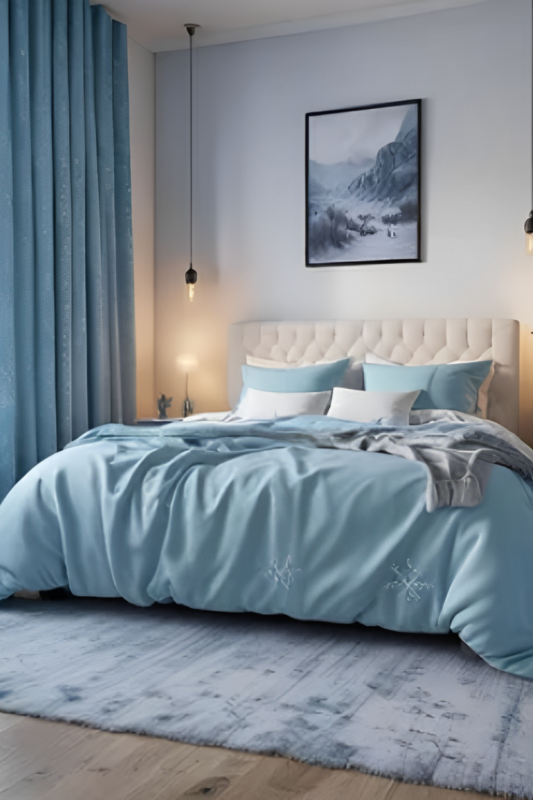
The Natural Touch: Soft Greens
Soft greens bring natural harmony to your bedroom while reducing stress. Their connection to nature makes them excellent at creating a calming atmosphere. These gentle hues evoke the peace of a garden or forest, building a subtle bridge between your indoor sanctuary and nature’s soothing elements. Research shows this natural connection enhances relaxation and improves sleep quality.
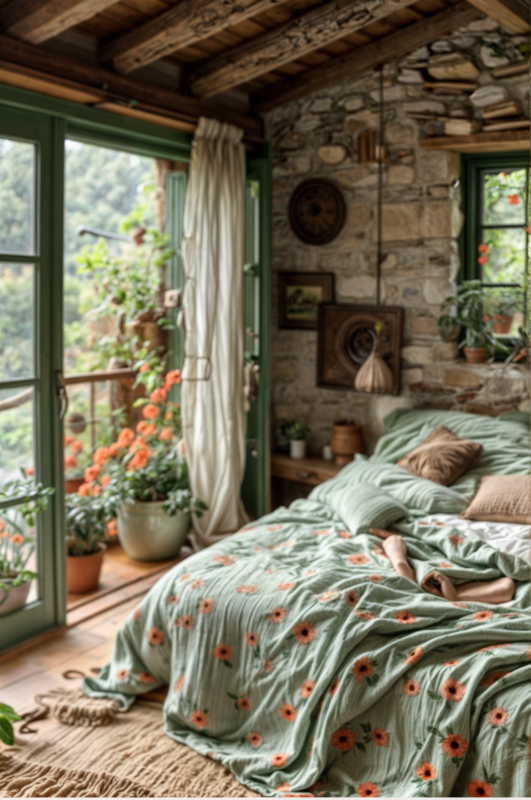
Gentle Neutrals: Versatile and Peaceful
For those seeking adaptability, gentle neutrals—sophisticated beiges, refined grays, and warm whites—offer an ideal solution. These versatile colors create a peaceful foundation while allowing flexibility in décor and styling. Neutral tones provide a subtle backdrop that adapts to changing moods and seasons while maintaining their sleep-promoting qualities.
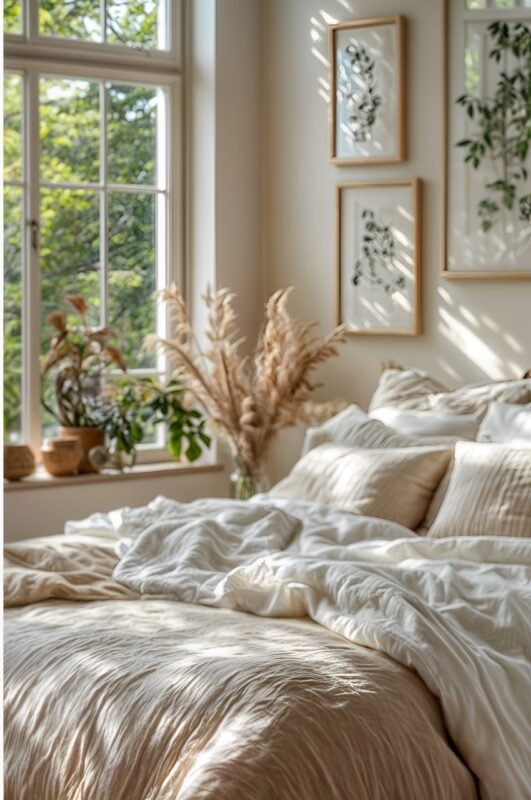
The science behind color psychology in bedrooms is well-established. Our color choices significantly impact both how easily we fall asleep and our sleep quality. By strategically using these colors, you can transform your bedroom from a simple sleeping space into a thoughtfully designed sanctuary that optimizes sleep and enhances overall well-being, supporting both physical health and mental clarity.
Colors to Avoid in Your Bedroom: Creating the Perfect Sleep Environment
When crafting your ideal sleep sanctuary, understanding which colors to avoid is equally crucial as knowing which ones to incorporate. The science of color psychology reveals that certain hues can significantly disrupt your sleep patterns and overall bedroom ambiance. Let’s explore the colors that research suggests should be carefully considered before including in your restful retreat:
- Bright Reds and Oranges: These energetic and stimulating colors can have a profound impact on your nervous system. Scientific studies have shown that exposure to these vibrant hues can increase heart rate and mental activity, making it particularly challenging to achieve the calm state necessary for quality sleep. Their intense wavelengths can trigger alertness responses in your brain, potentially disrupting your natural circadian rhythm.
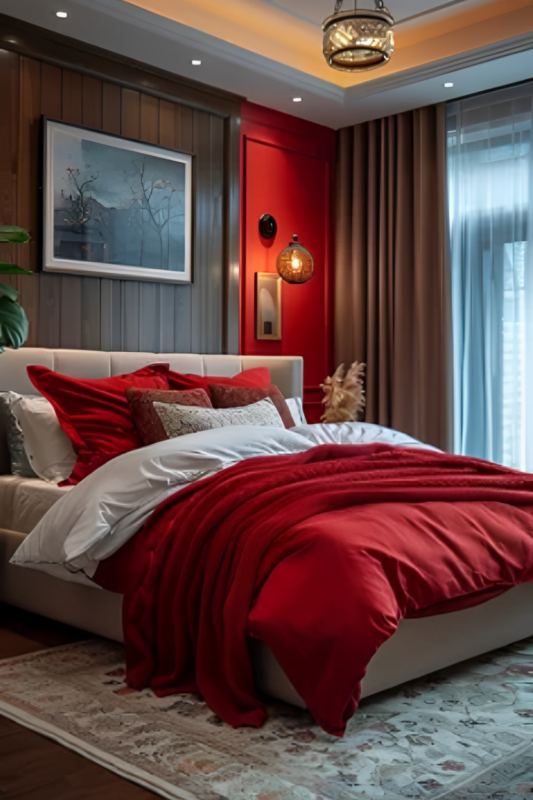
- Pure White: While often associated with cleanliness and simplicity, pure white in a bedroom setting can create an unexpectedly harsh environment. The stark nature of this color can reflect too much light, creating an institutional atmosphere that may subconsciously remind you of medical facilities. This association can interfere with the comfort and coziness essential for optimal rest.
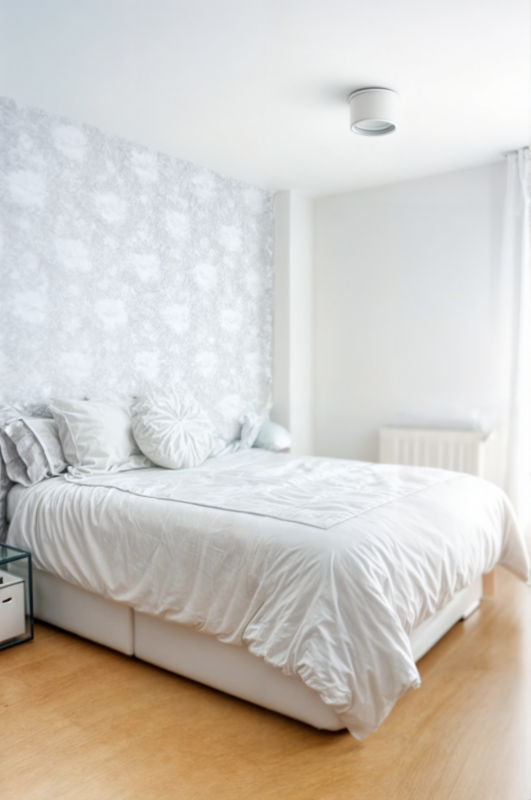
- Dark Browns: Although these deep earth tones might initially appear to offer warmth and groundedness, they can inadvertently create a heavy, overwhelming presence in your sleep space. Darker browns can absorb too much light, potentially leading to a cave-like effect that might trigger feelings of confinement or psychological heaviness.
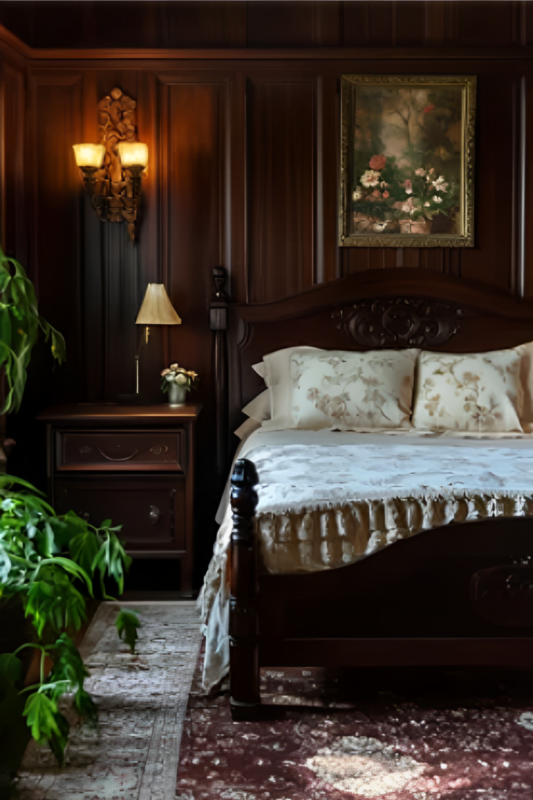
For a more sleep-conducive environment, consider incorporating colors that scientific research has proven to enhance relaxation and rest. Cool blues have been extensively studied and shown to significantly reduce both heart rate and blood pressure, creating an ideal physiological state for sleep. Soft, nature-inspired greens can activate your parasympathetic nervous system, helping to reduce stress levels and promote a sense of balance. For those seeking versatility without sacrificing tranquility, gentle neutrals offer an excellent alternative, providing a peaceful backdrop while maintaining the flexibility to adapt to various design preferences and seasonal changes.
Creating the Perfect Color Harmony in Your Bedroom
Mastering color combinations is essential for creating a harmonious bedroom that promotes quality sleep and wellbeing. The right selection and arrangement of colors can transform a simple sleeping area into a sophisticated sanctuary. Let’s explore the key color schemes that can revolutionize your bedroom:
Monochromatic Magic
A monochromatic color scheme uses varying shades, tints, and tones of a single color to create a sophisticated and harmonious look. This approach adds visual depth while maintaining cohesion throughout the space. For example, with blue—one of the most sleep-friendly colors—you might pair serene pale sky blue walls with rich navy accents and delicate powder blue textiles, creating a layered effect that’s both interesting and tranquil.
Balanced Complementary Colors
Complementary colors, which sit opposite each other on the color wheel, create a dynamic and striking balance. In bedroom design, use muted or pastel versions of these complementary colors to maintain a restful atmosphere. This approach adds visual interest while preserving the room’s purpose as a sleep sanctuary. The key is balancing visual engagement with relaxation.
The 60-30-10 Rule
This time-tested design principle creates a perfectly balanced color scheme. Here’s how to apply it:
- 60% should be your dominant color (usually walls and large surfaces), setting the room’s tone and creating a cohesive backdrop
- 30% should be your secondary color (furniture pieces and bedding), adding depth and visual layers
- 10% should be your accent color (decorative elements and accessories), providing finishing touches that complete the design
Remember, the ultimate goal is creating a peaceful environment that promotes rest and relaxation. Your color combinations should work together to support a calming atmosphere. Whether you choose a monochromatic scheme, balanced complementary colors, or the 60-30-10 approach, ensure each color choice contributes to your ideal sleep sanctuary.
Mastering Color Application Techniques in Your Bedroom
There are three key techniques to consider when applying color in your bedroom, each offering unique benefits for the overall atmosphere:
1. Accent Walls vs. Full Room Coverage
Choosing between an accent wall and full room coverage is a key decision that shapes your bedroom’s character. An accent wall creates a focal point and maintains visual balance—perfect for highlighting architectural features. Full room coverage, on the other hand, provides an immersive experience, wrapping the space in your chosen color for a unified, serene environment.
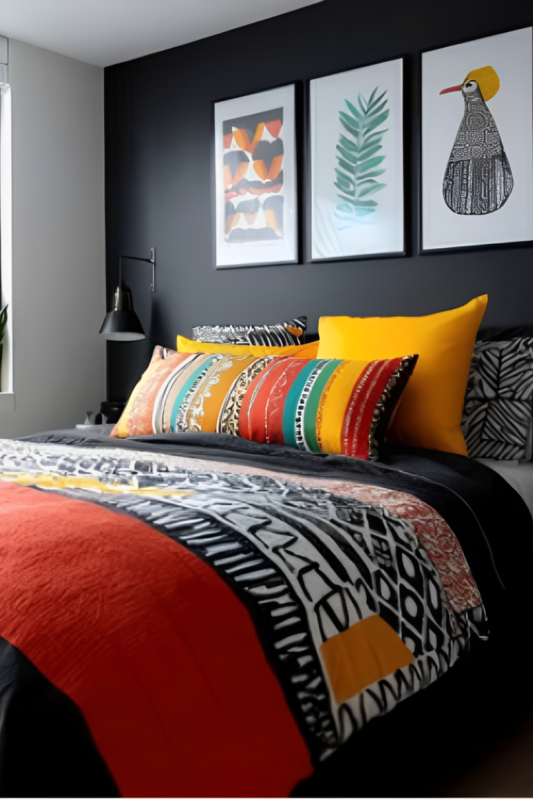
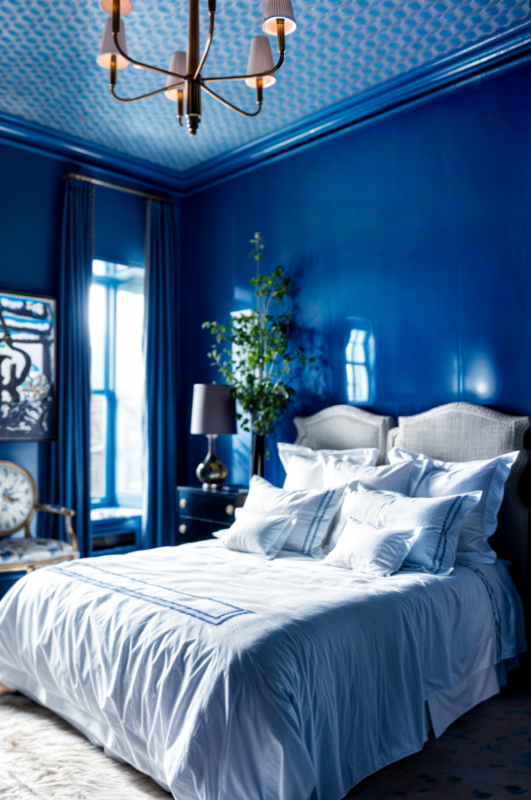
2. Color Blocking Strategies
Color blocking offers a modern way to use multiple colors in your bedroom. This technique helps define different areas without physical barriers. By using carefully chosen color combinations and geometric patterns, you can create visual interest while maintaining harmony. Strategic color block placement can emphasize or soften architectural features, reshaping how your space feels.
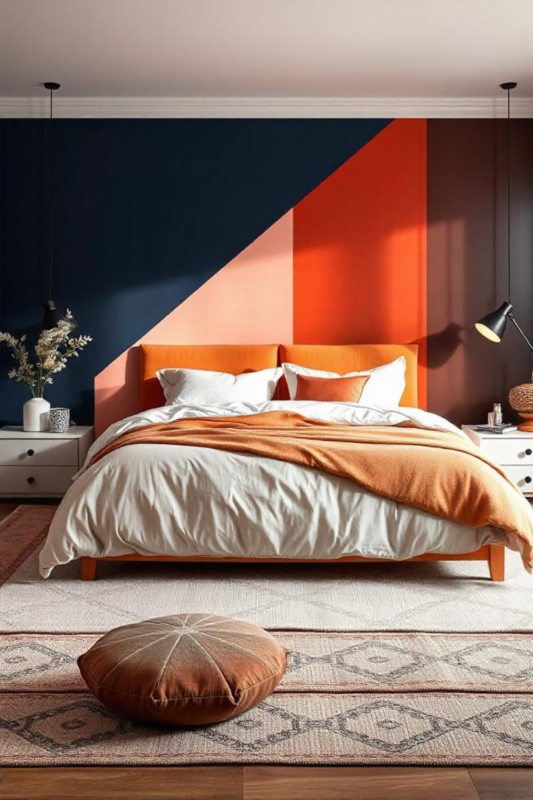
3. Working with Textiles
Textiles provide a flexible way to layer colors throughout your bedroom. Through bedding, window treatments, rugs, and pillows, you can add rich color and texture to your space. This approach is ideal for seasonal updates without permanent changes. Coordinating different textile elements creates an engaging mix of colors, patterns, and textures while maintaining design flexibility.
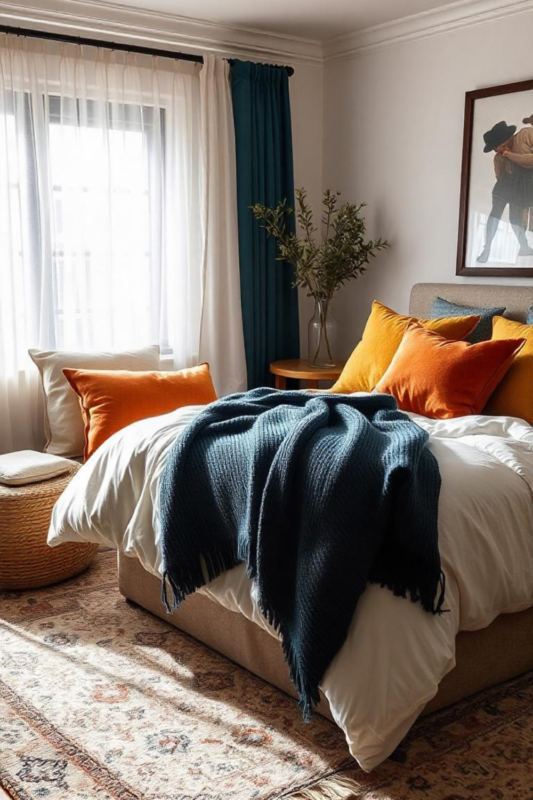
When using these techniques, remember the 60-30-10 rule of color distribution: 60% dominant color, 30% secondary colors, and 10% accent pieces. This classic approach creates a balanced, harmonious environment that promotes rest. Following this principle helps achieve a cohesive design that feels natural yet intentional.
Designing Different Bedroom Spaces: A Guide to Color and Size Considerations
Master Bedrooms vs. Guest Rooms
Master bedrooms serve as personal sanctuaries and require thoughtful color design. These intimate spaces should reflect the occupants’ personalities while using serene color palettes that promote relaxation and rejuvenation. The colors should support both restful sleep and peaceful morning routines. Guest rooms need a different approach—they should feature adaptable, universally appealing color schemes that create an inviting yet sophisticated atmosphere. The goal is to make visitors feel comfortable and welcomed, regardless of their preferences.
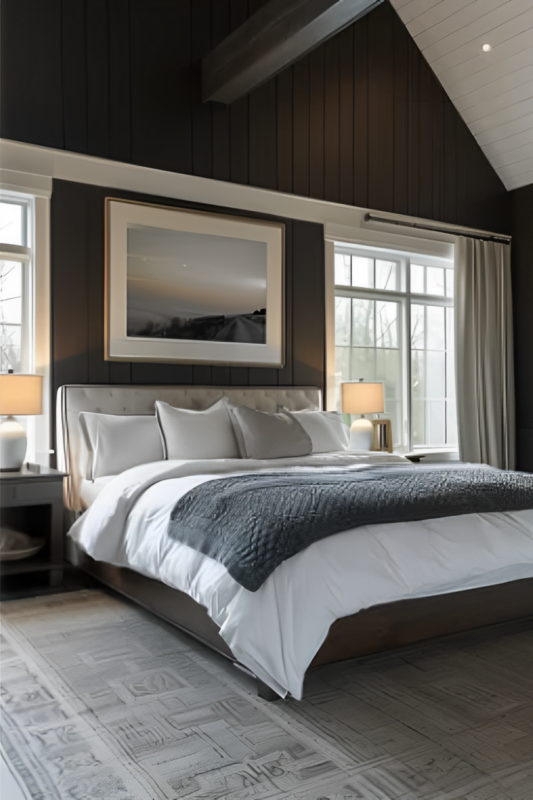
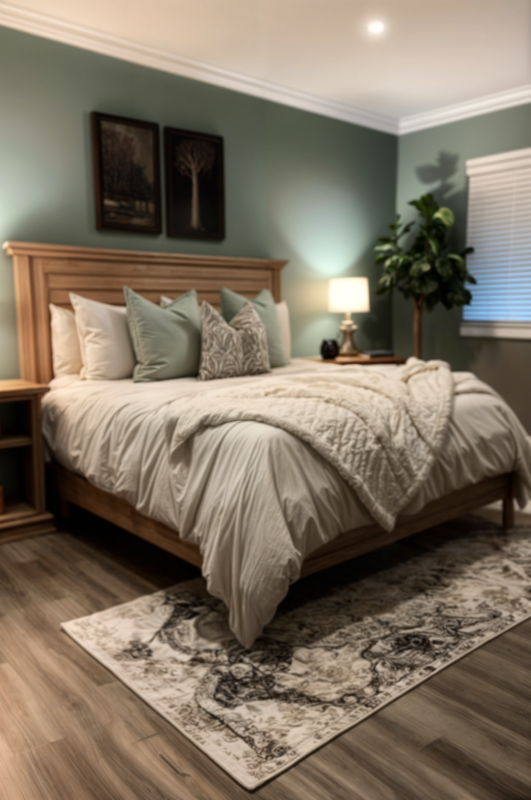
Children’s Bedrooms
Children’s bedrooms require a careful balance between stimulation and relaxation in color selection. While bright, energetic colors reflect youthful enthusiasm, the space must support both play and rest. The best approach uses calm, neutral base colors for walls, with vibrant accents added through changeable elements like artwork, pillows, and accessories. This layered approach creates visual interest and allows the space to evolve as the child grows, avoiding frequent major renovations while maintaining a sleep-friendly environment.
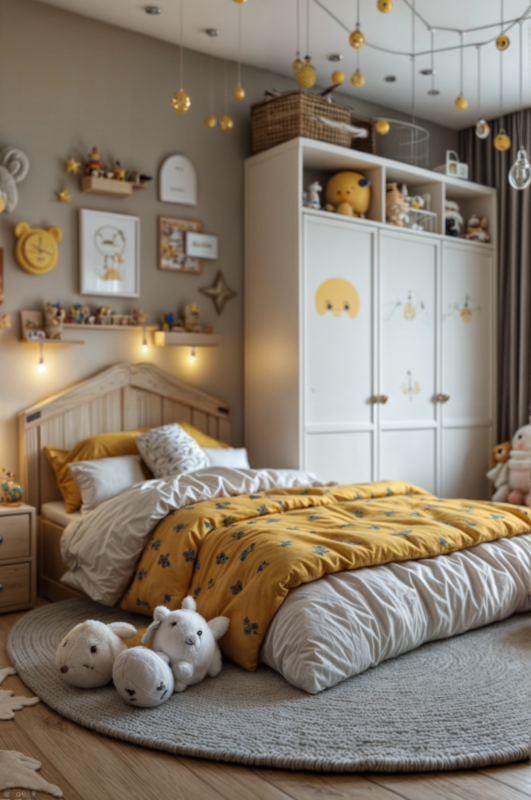
Small vs. Large Spaces
Room dimensions determine the most effective color strategies. In smaller bedrooms, lighter, reflective colors create a sense of spaciousness and airiness, making rooms feel larger than they are. Soft, cool tones work particularly well, as they visually expand the room’s boundaries. Larger bedrooms can handle darker or bolder colors without feeling overwhelming. In these spacious settings, strategic color placement helps create distinct functional areas—like sleeping zones, reading nooks, or dressing areas—while maintaining visual harmony.
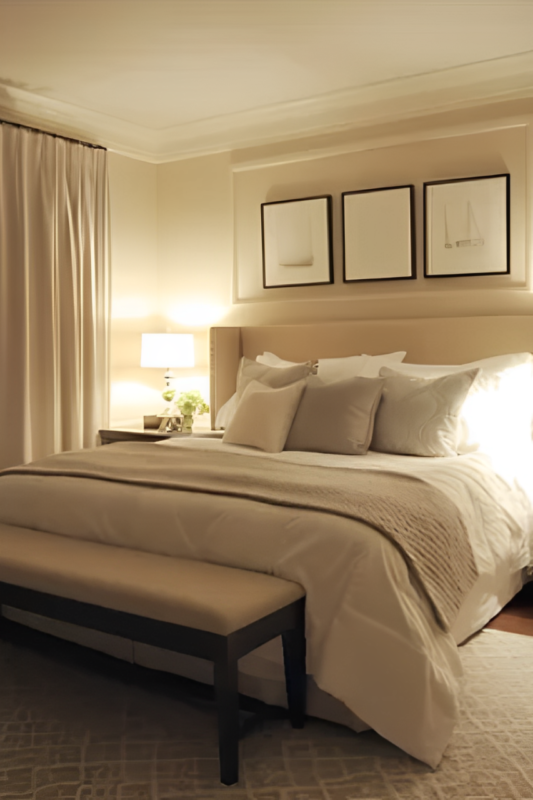
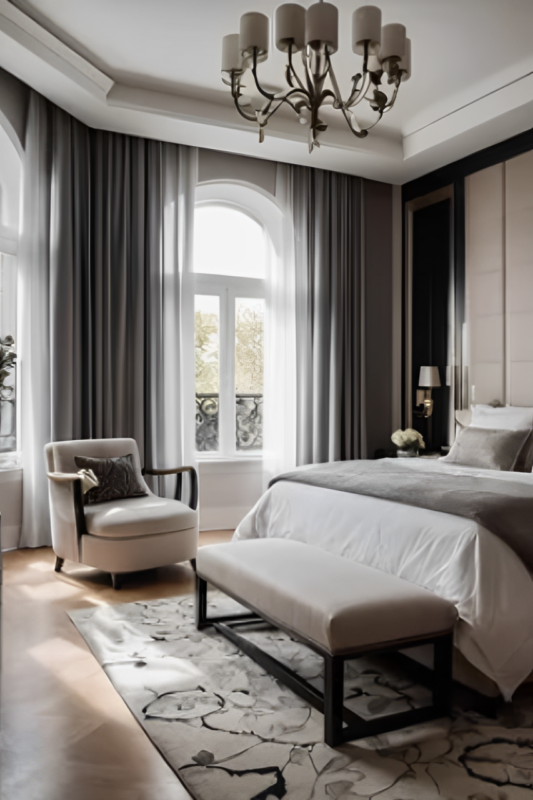
Remember that regardless of room type or size, the fundamental goal remains the same: to create a harmonious, balanced environment that promotes rest and relaxation while serving its purpose. Success comes from understanding how colors interact with space, light, and function to create the perfect atmosphere for each unique setting.
Practical Implementation: A Guide to Perfect Bedroom Colors
Successfully implementing your bedroom color scheme requires meticulous planning, thoughtful consideration, and careful attention to every detail. To achieve the most harmonious and visually pleasing results, follow this comprehensive implementation guide:
Testing Colors Before Commitment: A Scientific Approach
Before proceeding with any permanent color applications, it’s essential to conduct thorough testing in your specific space. Begin by purchasing sample pots of your chosen colors and creating substantial test swatches (measuring at least 2×2 feet) on multiple walls throughout the room. These larger swatches provide a more accurate representation of how the color will appear when applied to the entire surface. Observe these samples methodically throughout different times of day and evening, paying particular attention to how they interact with various lighting conditions. This crucial evaluation period allows you to witness how your selected colors transform under different circumstances, as the appearance of paint can vary dramatically depending on the quality and angle of light striking the surface.
Understanding Lighting’s Impact on Color Perception
The interplay between lighting and color in your bedroom creates a complex relationship that significantly influences the final aesthetic outcome:
- Natural light: Carefully evaluate your room’s directional exposure (north, south, east, or west facing) as this orientation fundamentally affects how colors manifest throughout the day. Northern light tends to be cooler, while southern exposure provides warmer, more consistent illumination
- Artificial lighting: The specific characteristics of different bulb types (ranging from warm to cool to daylight spectrum) can substantially transform color perception. Each lighting temperature creates distinct effects on your chosen colors
- Time of day: Colors undergo subtle but important transitions as natural light shifts from morning to evening, creating varying atmospheric effects throughout the daily cycle
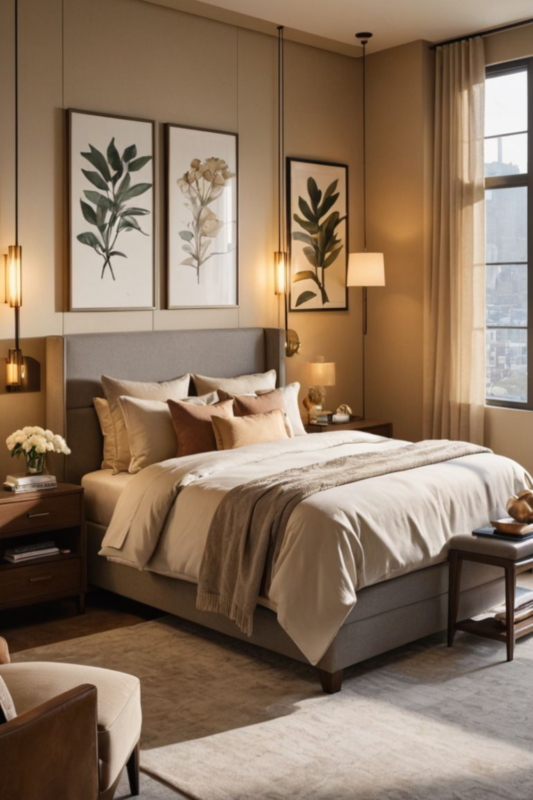
Professional Application vs. DIY Implementation: Making an Informed Choice
When determining whether to engage professional services or undertake the project yourself, consider these comprehensive factors:
- Professional benefits:
- Expert surface preparation techniques that ensure optimal paint adhesion and longevity
- Precise application methods that guarantee even coverage and clean lines
- Time-efficient project completion with minimal disruption to your daily routine
- Access to professional-grade tools, materials, and specialized equipment
- DIY considerations:
- Significant cost savings through personal labor investment
- Complete flexibility in project timeline and work schedule
- Deep personal satisfaction from hands-on involvement
- Total control over every aspect of the painting process
Regardless of which implementation path you select, remember that thorough preparation serves as the foundation for achieving a professional-quality finish that will maintain its beauty and integrity for years to come. This includes proper surface cleaning, repair of any imperfections, and appropriate priming before applying your chosen colors.
Maintaining Sleep-Friendly Colors: A Guide to Long-Term Bedroom Harmony
Establishing a sleep-conducive environment through thoughtful color selection is merely the first step in your bedroom’s journey—the true art lies in the ongoing cultivation and preservation of this carefully crafted peaceful atmosphere. The long-term success of your color scheme depends on dedicated maintenance and periodic adjustments to ensure your space continues to promote restful sleep and relaxation. Here’s a comprehensive guide to maintaining your bedroom’s sleep-friendly color environment:
Regular Maintenance Tips for Color Preservation
- Implement a weekly dusting routine for walls and surfaces to preserve color vibrancy and prevent dulling from accumulated particles
- Address scuff marks and blemishes immediately using appropriate cleaning methods to maintain the room’s serene aesthetic quality
- Monitor and quickly resolve any moisture-related issues to protect both the color integrity and underlying surface condition
- Maintain pristine window treatments through regular cleaning to ensure optimal light filtering and color reflection
Strategic Refresh and Repainting Schedule
- Establish a comprehensive repainting schedule every 3-5 years, adjusting the timeline based on environmental factors and wear patterns
- Conduct monthly assessments for color fading, paying particular attention to areas receiving direct sunlight exposure
- Implement a proactive annual touch-up routine for high-traffic zones to maintain consistent color appearance
Seasonal Color Harmony Adjustments
While maintaining your carefully selected sleep-promoting base colors, enhance your space seasonally through thoughtful accessory selection:
- Spring/Summer: Introduce lightweight textiles and accessories in gentle, cooling tones to create a fresh, airy atmosphere that promotes comfortable rest
- Fall/Winter: Layer the space with rich, warming accent pieces through carefully chosen throws, pillows, and seasonal decor elements
- Incorporate versatile, easily changeable decorative elements to adjust the room’s ambiance while preserving the essential peaceful color foundation
Remember that successful maintenance of a sleep-friendly color scheme requires attention to both the tangible aspects of color preservation and the subtle psychological elements that contribute to your room’s restful atmosphere. This dual focus ensures your bedroom remains an optimal environment for quality sleep throughout the changing seasons and years.
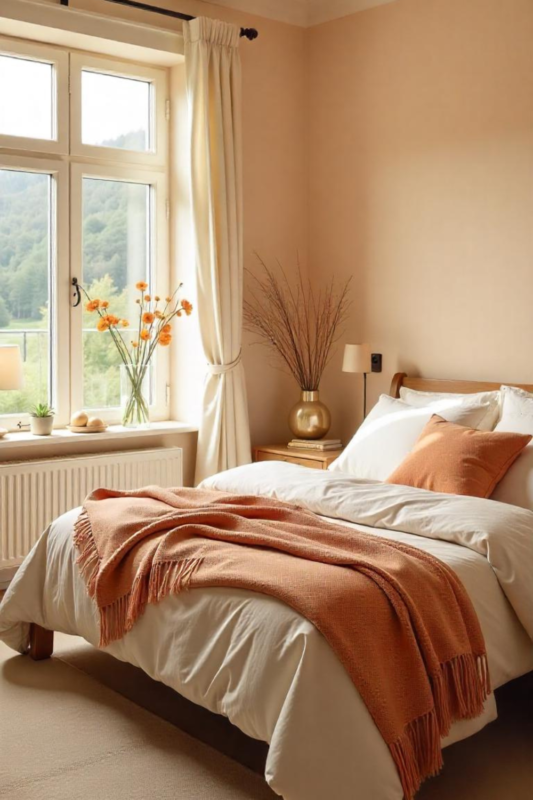
Conclusion
Creating the perfect bedroom color scheme requires a delicate balance of artistic intuition and scientific understanding. Through meticulous attention to color psychology principles, careful analysis of lighting conditions throughout the day, and thoughtful consideration of personal preferences and lifestyle needs, you can transform your bedroom into a harmonious sanctuary that not only promotes restful sleep but also nurtures emotional wellbeing and creates a lasting sense of tranquility.
Key Takeaways:
- Select colors that actively promote relaxation and rest, paying careful attention to the established 60-30-10 rule for achieving optimal color distribution and visual harmony throughout the space
- Carefully evaluate your room’s unique characteristics – including dimensions, natural light patterns throughout the day, architectural features, and intended purpose – when making color selections
- Conduct thorough color testing under various lighting conditions before making final commitments, and implement proper maintenance routines to ensure lasting beauty and effectiveness
Long-Term Benefits:
- Significantly improved sleep quality through a meticulously curated environment that promotes natural circadian rhythms
- Notably enhanced mood and emotional wellbeing through thoughtful color psychology implementation
- Substantial increase in property value through sophisticated and well-executed design choices
Final Recommendations:
- Dedicate adequate time to the selection process – hasty decisions in color choice often lead to costly mistakes and potential regret
- Make worthwhile investments in premium materials and professional application techniques to ensure optimal results
- Ensure your bedroom reflects your unique personal style while maintaining its essential function as a dedicated space for rest, rejuvenation, and peaceful contemplation
>> Learn more: How to Choose the Perfect Living Room Decor Colors


